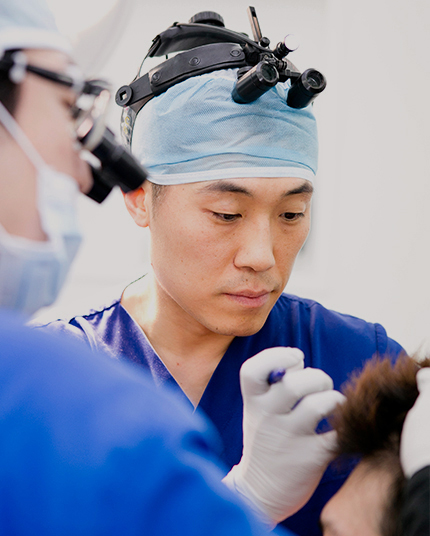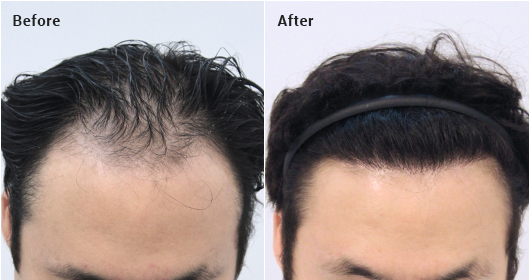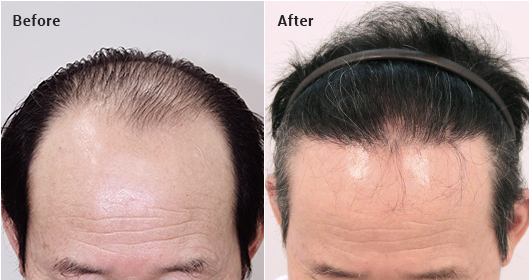30 years of FORHAIR FUE hair transplant All you need to know about FUE. Our results speak for themselves.
A promise for highest satisfaction
Hair implantation is not a competition simply to increase
the graft survival rate. It is necessary to view the forest rather than
just the trees and to design a harmonious and beautiful forest.
In particular, large quantity implantation is at its summit.
The criteria for large quantity implantation generally involves numbers of hair
follicles in the range of 2,000~4,000 (approximately 4,000~8,000 hair strands).
Although we would very much like to implant abundant amounts of hair to everyone,
the quantity of implantation needs to be decided according to the quantity
of hair follicles that can be collected from the donor area.
We are not trying to emphasize the limitations of large quantity implantation.
It is possible to achieve sufficiently satisfactory results even with a small
quantity of hair follicles, depending on how the limited quantity of hair
follicles is distributed and designed. This can be achieved by the skill
of a surgeon. As such, FORHAIR is the right choice for large quantity implantation as well.

with limited numbers of hair follicles
Patients who have worn wigs for many years frequently expect to achieve the same abundance of hair with hair implantation as a wig.
However, the quantity of implantation is determined by the limited supply of hair follicles from the donor area.
As such, those who require large quantity implantation may also have insufficient quantity that can be collected from
the donor area. Therefore, although it is possible to increase the density to about 70% of the normal density
in the case of general hair transplant, it fluctuates widely in the case
of large quantity implants depending on the extent of hair loss and conditions of the donor area.
However, we do not agree that the expectations should be lowered, even in the case of large quantity
implants because it is possible to achieve sufficiently satisfactory results even with a limited number of
hair follicles that can be collected. This is the reason for the existence of FORHAIR.
-
 Non-shaven FUE, 2000 grafts, After 7 months
Non-shaven FUE, 2000 grafts, After 7 months
-
 Partial-shaven FUE, 2000 grafts, After 10 months
Partial-shaven FUE, 2000 grafts, After 10 months
Supplementing weaknesses and maximizing strengths
Many patients who need large quantity implantation frequently display severe M-shaped hair loss that has progressed to the crown of the head. Although it would be great if abundant hair could be achieved on both the front of the forehead and crown through large quantity implantation, the number of hair follicles that can be implanted is limited.
Accordingly, it is very important to distribute and design hair follicles by deciding
how densely the hair follicles will be implanted in various parts of the head.
As such, we fully utilize the strengths of patients by means of designs that consider even their lifestyle by having sufficient conversation with and reflecting the opinions of patients in order to increase the density in the forehead portion or, conversely, filling in the empty area in the crown while leaving the forehead a bit wider in accordance with patients’ facial proportions, occupation, and normal hairstyle.
-
 Partial-shaven FUE, 2000 grafts, After 10 months
Partial-shaven FUE, 2000 grafts, After 10 months
-
 Non-shaven FUE, 2000 grafts, After 10 months
Non-shaven FUE, 2000 grafts, After 10 months
The shape and height of the forehead is important as it could determine the impression of a person.
Unless the implant quantity is extremely inadequate, we increase the density in the frontal portion of the
forehead that accounts for majority of hair styling. As such, we implant the hair follicles by
dispersing them with natural gradation by lowering the density towards the crown of the head.
-
Is it difficult to implant large quantities through FUE hair transplant?
This is a misconception arising from the fact that FUE hair transplant takes more time than FUT hair transplant,
and it is not true. FORHAIR, regardless of the surgical procedure, completes implantation within 1 hour of hair follicle collection on principle and, as such, is not restricted by a long surgery duration or the time period that hair follicles spend outside the body.
The most important fact to consider is graft survival rate. Patients in need of large quantity hair transplant has low hair density in the occipital region. So, when excessively large number of hair grafts are collected, it impacts stress on the scalp and hair follicles which might lead to a drop in the engraftment rate.
FORHAIR, can implant up to 2,500 hair follicles (approximately 5,000 hair strands) per surgery on the same day, and provides satisfactory results by stably collecting healthy hair follicles only. - Is it advantageous to execute large quantity implantation in a single procedure?
with the minimum number of grafts
A second surgery is recommended only if necessary
Hair transplant is a surgical procedure that needs to produce the
maximum effects with limited number of hair follicles.
Although it would be great to implant as many hair follicles as possible in a
single session, hair loss can progress further in the future and a second surgery may be necessary.
As such, the quantity to be implanted needs to be decided with consideration of various factors.
In most cases of patients needing large quantity implantation, they have experienced significant hair loss in the frontal part of the head. Although it is difficult to restore the frontal part by means other than hair transplant, it is possible to delay the pace of hair loss progress or achieve partial restoration through drug therapy. Although each patient displays different responses to the drugs, if outstanding effects are achieved then density of the frontal portion, which is most important, will be increased. After having observed the progress of drug therapy for the crown portion of the head for a period of approximately one year, we will recommend a second surgery only if further implantation is absolutely necessary.

